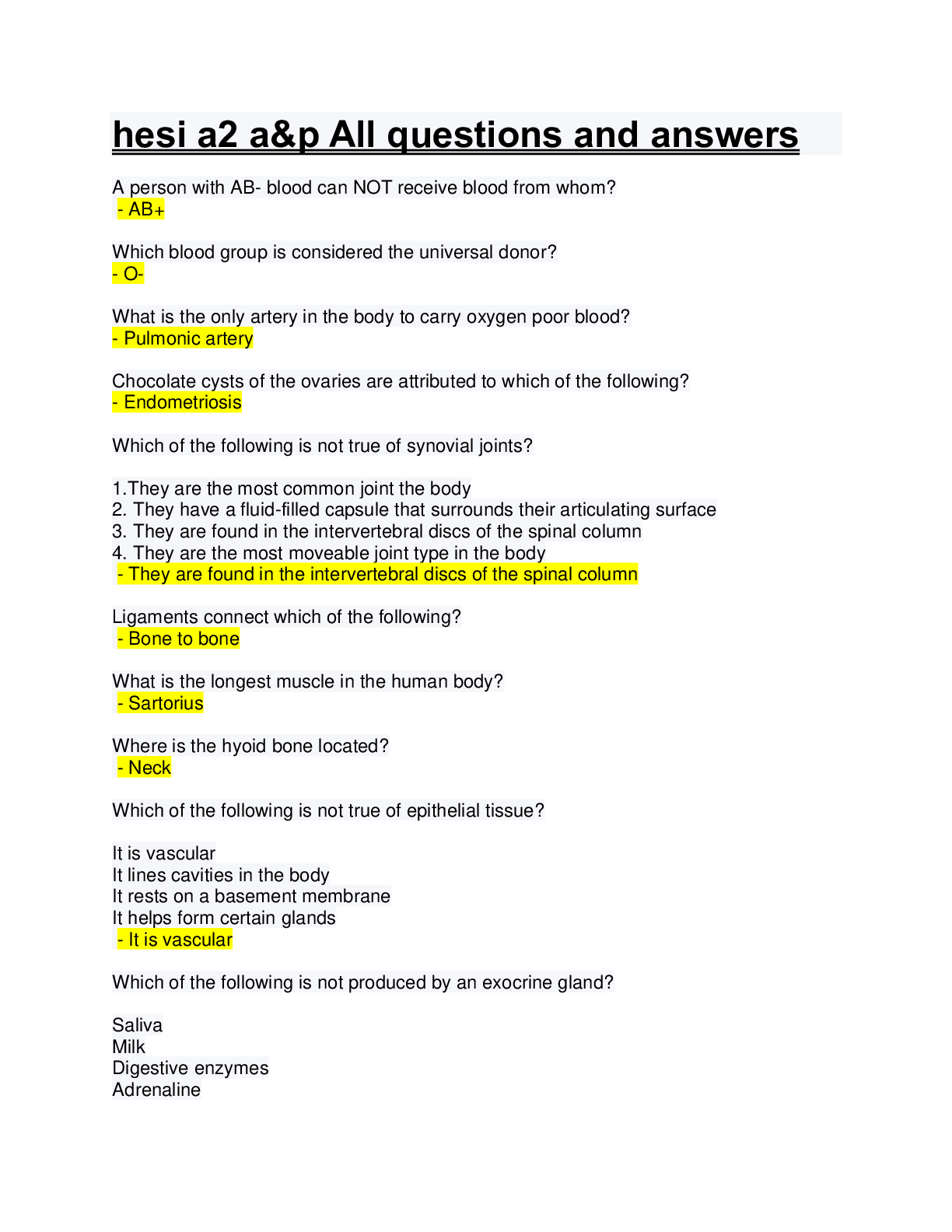*NURSING > HESI > EXIT HESI Comprehensive B Evolve Practice Questions and answers, 100% pass rate, 2022/2023 update. (All)
EXIT HESI Comprehensive B Evolve Practice Questions and answers, 100% pass rate, 2022/2023 update.
Document Content and Description Below
EXIT HESI Comprehensive B Evolve Practice Questions and answers, 100% pass rate, 2022/2023 update. The nurse is caring for a client with a cerebrovascular accident (CVA) who is receiving enteral ... tube feedings. Which task performed by the UAP requires immediate intervention by the nurse? A.Suctions oral secretions from mouth B.Positions head of bed flat when changing sheets C.Takes temperature using the axillary method D.Keeps head of bed elevated at 30 degrees - ✔✔B Rationale: Positioning the head of the bed flat when enteral feedings are in progress puts the client at risk for aspiration (B). The others are all acceptable tasks performed by the UAP (A, C, and D). When caring for a postsurgical client who has undergone multiple blood transfusions, which serum laboratory finding is of most concern to the nurse? A.Sodium level, 137 mEq/L B.Potassium level, 5.5 mEq/L C.Blood urea nitrogen (BUN) level, 18 mg/dL D.Calcium level, 10 mEq/L - ✔✔B Rationale: Multiple blood transfusions are a risk factor for hyperkalemia. A serum potassium level higher than 5.0 mEq/L indicates hyperkalemia (B). The others are normal findings (A, C, and D). Which vaccination should the nurse administer to a newborn? A.Hepatitis B B.Human papilloma virus (HPV) C.Varicella D.Meningococcal vaccine - ✔✔A Rationale: The hepatitis B vaccination should be given to all newborns before hospital discharge (A). HPV is not recommended until adolescence (B). Varicella immunization begins at 12 months (C). Meningococcal vaccine is administered beginning at 2 years (D). The nurse is caring for a client on the medical unit. Which task can be delegated to unlicensed assistive personnel (UAP)? A.Assess the need to change a central line dressing. B.Obtain a fingerstick blood glucose level. C.Answer a family member's questions about the client's plan of care. D.Teach the client side effects to report related to the current medication regimen. - ✔✔B Rationale: Obtaining a fingerstick blood glucose level is a simple treatment and is an appropriate skill for UAP to perform (B). (A, C, and D) are skills that cannot be delegated to UAP. The nurse is caring for a client with an ischemic stroke who has a prescription for tissue plasminogen activator (t-PA) IV. Which action(s) should the nurse expect to implement? (Select all that apply.) A.Administer aspirin with tissue plasminogen activator (t-PA). B.Complete the National Institute of Health Stroke Scale (NIHSS). C.Assess the client for signs of bleeding during and after the infusion. D.Start t-PA within 6 hours after the onset of stroke symptoms. E.Initiate multidisciplinary consult for potential rehabilitation. - ✔✔B,C,E Rationale: Neurologic assessment, including the NIHSS, is indicated for the client receiving t-PA. This includes close monitoring for bleeding during and after the infusion; if bleeding or other signs of neurologic impairment occur, the infusion should be stopped (B, C, and E). Aspirin is contraindicated with t-PA because it increases the risk for bleeding (A). The administration of t-PA within 6 hours of symptoms is concurrent with a diagnosis of a myocardial infarction and within 4.5 hours of symptoms is concurrent for a stroke (D). When caring for a client in labor, which finding is most important to report to the primary health care provider? A.Maternal heart rate, 90 beats/min. B.Fetal heart rate, 100 beats/min C.Maternal blood pressure, 140/86 mm Hg D.Maternal temperature, 100.0° F - ✔✔B Rationale: A fetal heart rate (FHR) of 100 beats/min may indicate fetal distress (B) because the average FHR at term is 140 beats/min and the normal range is 110 to beats/min 160. The others (A, C, and D) are normal findings for a woman in labor. The nurse is caring for a client with heart failure who develops respiratory distress and coughs up pink frothy sputum. Which action should the nurse take first? A.Draw arterial blood gases. B.Notify the primary health care provider. C.Position in a high Fowler's position with the legs down. D.Obtain a chest X-ray. - ✔✔C Rationale: Positioning the patient in a high Fowler's position with dangling feet will decrease further venous return to the left ventricle (C). The other actions should be performed after the change in position (A, B, and D). A client who is prescribed chlorpromazine HCl (Thorazine) for schizophrenia develops rigidity, a shuffling gait, and tremors. Which action by the nurse is most important?A.Administer a dose of benztropine mesylate (Cogentin) PRN. B.Determine if the client has increased photosensitivity. C.Provide comfort measures for sore muscles. D.Assess the client for visual and auditory hallucinations. - ✔✔A Rationale: Rigidity, shuffling gait, pill-rolling hand movements, tremors, dyskinesia, and masklike face are extrapyramidal side effects associated with Thorazine. It is most important for the nurse to administer an anticholinergic such as Cogentin to reverse these effects (A). The others (B, C, D) may be appropriate interventions but are not as urgent as (A). A nurse is interviewing a mother during a well-child visit. Which finding would alert the nurse to continue further assessment of the infant? A.Two-month-old who is unable to roll from back to abdomen B.Ten-month-old who cannot sit without support C.Nine-month-old who cries when his mother leaves the room D.Eight-month-old who has not yet begun to speak words - ✔✔B Rationale: As a developmental milestone, infants should sit unsupported by 8 months (B). The milestone of rolling over is achieved at 5 to 6 months for most infants (A). Stranger anxiety is common from 7 to 9 months (C). Speaking a few words is expected at about 12 months (D). Which intervention should be included in the plan of care for a client admitted to the hospital with ulcerative colitis? A.Administer stool softeners. B.Place the client on fluid restriction. C.Provide a low-residue diet. D.Add a milk product to each meal. - ✔✔C Rationale: A low-residue diet (C) will help decrease symptoms of diarrhea, which are clinical manifestations of ulcerative colitis. (A, B, and D) are contraindicated and could worsen the condition. The nurse is caring for a client with deep vein thrombosis who is on a continuous IV heparin infusion. The activated partial prothrombin time (aPTT) is 120 seconds. Which action should the nurse take? A.Increase the rate of the heparin infusion using a nomogram. B.Decrease the heparin infusion rate and give vitamin K IM. C.Continue the heparin infusion at the current prescribed rate. D.Stop the heparin drip and prepare to administer protamine sulfate. - ✔✔D Rationale: An aPTT more than 100 seconds is a critically high value; therefore, the heparin should be stopped. The antidote for heparin is protamine sulfate (D). Increasing the rate would increase the risk for hemorrhage (A). The infusion should be stopped, and vitamin K is the antidote for warfarin (Coumadin) (B). Keeping the infusion at the current rate would increase the risk for hemorrhage (C). While assessing a client with recurring chest pain, the unit secretary notifies the nurse that the client's health care provider is on the telephone. What action should the nurse instruct the unit secretary to implement? A.Transfer the call into the room of the client. B.Instruct the secretary to explain reason for the call. C.Ask another nurse to take the phone call. D.Ask the health care provider to see the client on the unit. - ✔✔C Rationale: Another nurse should be asked to take the phone call (C), which allows the nurse to stay at the bedside to complete the assessment of the client's chest pain. (A and B) should not be done during an acute change in the client's condition. Requesting the health care provider (D) to come to the unit is premature until the nurse completes assessment of the client's status. Which instruction(s) should the nurse include in the discharge teaching plan of a male client who has had a myocardial infarction and who has a new prescription for nitroglycerin (NTG)? (Select all that apply.) A.Keep the medication in your pocket so that it can be accessed quickly. B.Call 911 if chest pain is not relieved after one nitroglycerin. C.Store the medication in its original container and protect it from light. D.Activate the emergency medical system after three doses of medication. E.Do not use within 1 hour of taking sildenafil citrate (Viagra). - ✔✔B,C Rationale: Emergency action should be taken if chest pain is not relieved after one nitroglycerin tablet (B). The medication should be kept in the original container to protect from light (C). Keeping the medication in the shirt pocket provides an environment that is too warm (A). The newest guidelines recommend calling 911 after one nitroglycerin tablet if chest pain is not relieved (D). Nitroglycerin and other nitrates should never be taken with Viagra (E). The nurse prepares to administer 3 units of regular insulin and 20 units of NPH insulin subcutaneously to a client with an elevated blood glucose level. Which procedure is correct? A.Using one syringe, first insert air into the regular vial and then insert air into the NPH vial. B.Using one syringe, add the regular insulin into the syringe and then add the NPH insulin. C.Avoid combining the two insulins because incompatibility could cause an adverse reaction. D.Administer the regular insulin subcutaneously and then give the NPH IV to prevent a separate stick. - ✔✔B Rationale: The regular or "clear" insulin should be withdrawn into the syringe first, followed by the NPH (B). Air should first be injected into the NPH vial and then air should be inserted into the regular vial (A). NPH and regular insulin are compatible, and combining will reduce the number of injections (C). The insulin is ordered subcutaneously and NPH cannot be given IV (D). An 8-year-old child is receiving digoxin (Lanoxin) for congestive heart failure (CHF). In assessing the child, the nurse finds that her apical heart rate is 80 beats/min, she complains of being slightly nauseated, and her serum digoxin level is 1.2 ng/mL. What action should the nurse take? A.Because the child's heart rate and digoxin level are within normal range, assess for the cause of the nausea. B.Hold the next dose of digoxin until the health care provider can be notified because the serum digoxin level is elevated. C.Administer the next dose of digoxin and notify the health care provider that the child is showing signs of toxicity. D.Notify the health care provider that the child's pulse rate is below normal for her age group. - ✔✔A Rationale: Nausea and vomiting are early signs of digoxin toxicity. However, the normal resting heart rate for a child 8 to 10 years of age is 70 to 110 beats/min and the therapeutic range of serum digoxin levels is 0.5 to 2 ng/mL. Based on the objective data, (A) is the best of the choices provided because the serum digoxin level is within normal levels. (B) is not warranted by the data presented. The digoxin level is within the therapeutic range and the child is not showing signs of toxicity (C). The child's pulse rate is within normal range for her age group (D). The nurse prepares to administer acetaminophen oral suspension to a child who weighs 66 pounds. The prescription reads: Administer 15 mg/kg every 6 hours by mouth. The Tylenol is available 150 mg/5 ml. Which is the correct dosage indicated on the image? A.30ml B.15ml C.10ml D.5ml - ✔✔B Rationale: 66 lb/(2.2 kg/lb) = 30 kg 30 kg × (15 mg/kg) = 450 mg (5 mL/150 mg) × 450 mg = 15 mL or (450 mg/150 mg) × 5 mL = 15 mL When assessing the laboratory findings of a 38-year-old client with tuberculosis who is taking rifampin (Rifadin), which laboratory finding would be most important to report to the primary health care provider immediately? A.Orange-colored urine B.Potassium level, 4.9 mEq/L C.Elevated liver enzyme levels D.Blood urea nitrogen (BUN) level, 12 mg/dL - ✔✔C Rationale: Rifampin can cause hepatoxicity, so elevated liver enzyme levels need to be closely monitored and reported to the health care provider (C). Orange discoloration of the urine is an expected side effect of this medication (A). The potassium level (B) is normal. A BUN level of 12 mg/dL is within defined parameters (D). A client is receiving propylthiouracil (PTU) prior to thyroid surgery. Which diagnostic test results indicate that the medication is producing the desired effect? A.Increased hemoglobin and hematocrit levels B.Increased serum calcium level C.Decreased white blood cell (WBC) count D.Decreased triiodothyronine (T3) and thyroxine (T4) levels - ✔✔D Rationale: Propylthiouracil (PTU) is an adjunct therapy used to control hyperthyroidism by inhibiting the production of thyroid hormones (D). It is often prescribed in preparation for thyroidectomy or radioactive iodine therapy. It is does not affect (A). (B) must be monitored after surgery in case the parathyroid glands were removed, but preoperative PTU does not increase the serum calcium level. If the client has an infection preoperatively, antibiotics will be given and (C) monitored. The nurse teaches a class on bioterrorism. Which method(s) of transmission is(are) possible with the biologic agent Bacillus anthracis (Anthrax)? (Select all that apply.) A.Inhalation of powder form B.Handling of infected animals C.Spread from person to person through coughing D.Eating undercooked meat from infected animals E.Direct cutaneous contact with the powder - ✔✔A,B,D,E Rationale: Anthrax can be transmitted by the inhalation, cutaneous, and digestive routes (A, B, D, and E); however, the disease is not spread from person to person (C). The nurse assesses a woman in the emergency room who is in her third trimester of pregnancy. Which finding(s) is(are) indicative of abruptio placentae? (Select all that apply.) A.Dark red vaginal bleeding B.Rigid boardlike abdomen C.Soft abdomen on palpation D.Complaints of severe abdominal pain E.Painless bright red vaginal bleeding - ✔✔A,B,D Rationale: These are all signs of abruptio placentae (A, B, and D). The others are signs of placenta previa (C and E). Which vital sign in a pediatric client is most important to report to the primary health care provider? A.Newborn with a heart rate of 140 beats/min B.Three-year-old with a respiratory rate of 28 breaths/min C.Six-year-old with a heart rate of 130 beats/min D.Twelve-year-old with a respiratory rate of 16 breaths/min - ✔✔C Rationale: The normal heart rate for a 6- to 10-year-old is 70 to 110 beats/min (C). The others are all within normal range for those ages (A, B, and D). Which finding should be reported to the primary health care provider when caring for a client who has a continuous bladder irrigation after a transurethral resection of the prostate gland (TURP)? A.The client reports a continuous feeling of needing to void. B.Urinary drainage is pink 24 hours after surgery. C.The hemoglobin level is 8.4 g/dL 3 days postoperatively. D.Sterile saline is being used for bladder irrigation. - ✔✔C Rationale: A hemoglobin level of 8.4 g/dL is abnormally low and may indicate hemorrhage (C). The others are all expected findings after a TURP (A, B, and D). Which of the following cardiac rhythms is represented in the image? A.Normal sinus rhythm B.Sinus tachycardia C.Ventricular fibrillation D.Atrial fibrillation - ✔✔C Rationale: Ventricular fibrillation (C) is a life-threatening arrhythmia characterized by irregular undulations of varying amplitudes. (A, B, and D) are not represented in the image. An adult client with a medical diagnosis of substance abuse and schizophrenia was recently switched from oral fluphenazine HCl (Prolixin) to IM fluphenazine decanoate (Prolixin Decanoate) because of medication noncompliance. What should the nurse teach the client and family about this change in medication regimen? A.Long-acting medication is more effective than daily medication. B.A client with substance abuse must not take any oral medications. C.There will continue to be a risk of alcohol and drug interaction. D.Support groups are only helpful for substance abuse treatment. - ✔✔C Rationale: Alcohol enhances the side effects of Prolixin. The half-life of Prolixin PO is 8 hours, whereas the half-life of the Prolixin Decanoate IM is 2 to 4 weeks. Therefore, the side effects of drinking alcohol are far more severe when the client drinks alcohol after taking the long-acting Prolixin Decanoate IM (C). (A, B, and D) provide incorrect information. A client comes to the obstetric clinic for her first prenatal visit and complains of feeling nauseated every morning. The client tells the nurse, "I'm having second thoughts about wanting to have this baby." Which response is best for the nurse to make? A."It's normal to feel ambivalent about a pregnancy when you are not feeling well." B."I think you should discuss these feelings with your health care provider." C."How does the father of your child feel about your having this baby?" D."Tell me about these second thoughts you are having about this pregnancy." - ✔✔D Rationale: Although ambivalence is normal during the first trimester, (D) is the best nursing response at this time. It is reflective and keeps the lines of communication open. (A) is not the best response because it offers false reassurance. (B) dismisses the client's feelings. The nurse should use communication skills that encourage this type of discussion, not shift responsibility to the care provider. (C) may eventually be discussed, but it is not the most important information to obtain at this time. A nurse performs an initial admission assessment of a 56-year-old client. Which factor(s) would indicate that the client is at risk for metabolic syndrome? (Select all that apply.) A.Abdominal obesity B.Sedentary lifestyle C.History of hypoglycemia D.Hispanic or Asian ethnicity E.Increased triglycerides - ✔✔A,B,D,E Rationale: Metabolic syndrome is a name for a group of risk factors that increase the risk for coronary artery disease, type 2 diabetes, and stroke (A, B, D, and E). Hypoglycemia is not a risk factor for metabolic syndrome (C). The nurse administers regular insulin (human), 8 units subcutaneously, to a client at 8:00 am, 30 minutes before breakfast. At what time is the client most at risk for a hypoglycemic reaction? A.9:30 am B.10:30 am C.12:00 pm D.3:00 pm - ✔✔B Rationale: Regular insulin is short-acting and peaks between 2 and 3 hours after administration (B). The client is most at risk for a hypoglycemic reaction during the peak times. (A, C, and D) are not high-risk times for the client to experience hypoglycemia because they do not fall within the peak time. Which intervention is most important when caring for a client immediately after electroconvulsive therapy (ECT)?A.Reorient the client to surroundings. B.Assess blood pressure every 15 minutes. C.Determine if muscle soreness is present. D.Maintain a patent airway. - ✔✔D Rationale: The client is typically unconscious immediately following ECT, and nausea is a common side effect. The nurse should take measures to prevent aspiration and maintain a patent airway (D). Patients may be confused after ECT (A), but reorientation is not as high a priority as the airway. Although vital signs should be assessed, the airway is a higher priority (B). Muscle soreness is an expected finding after ECT (C). The nurse prepares to administer ophthalmic drops to a client prior to cataract surgery. List the steps in the order that they should be implemented from first step to final step. A. Drop prescribed number of drops into conjunctival sac. B. Wash hands and apply clean gloves. C. Place dominant hand on the client's forehead. D. Ask the client to close the eye gently. A. C, B, A, D B. B, C, A, D C. A, B, D, C D. A, C, B, D - ✔✔B Rationale: Washing hands and applying gloves prior to procedure initiation prevents the spread of infection (B). Placing the dominant hand on the client's forehead (C) stabilizes the hand so the nurse can hold the dropper 1 to 2 cm above the conjunctival sac and drop the prescribed number of drops (A); asking the client to close the eye gently helps distribute the medication (D). A client with bipolar disorder is seen in the mental health clinic for evaluation of a new medication regimen that includes risperidone (Risperdal). The nurse notes that the client has gained 30 lb in the past 3 months. Which assessment is most important for the nurse to obtain? A.Compliance with medication regimen B.Current thyroid-stimulating hormone (TSH) level C.Occurrence of mania or depression D.A 24-hour diet and exercise recall - ✔✔A Rationale: Medication compliance (A) is most important for the treatment of psychotic disorders and, because Risperdal is associated with weight gain, it is probable that the client is complying with the treatment plan. The TSH level (B) indicates thyroid function, which regulates basal metabolic rate and influences weight. It is important to obtain information about occurrences of mania and depression (C) since the last visit, but if the client is compliant with the medication regimen, these symptoms are likely to have been controlled. Diet and exercise (D) should also be assessed, but weight gain is a likely indicator of medication compliance. The nurse is caring for a client with chronic renal failure (CRF) who is receiving dialysis therapy. Which nursing intervention has the greatest priority when planning this client's care? A.Palpate for pitting edema. B.Provide meticulous skin care. C.Administer phosphate binders. D.Monitor serum potassium levels. - ✔✔D Rationale: Clients with CRF are at risk for electrolyte imbalances, and imbalances in potassium can be life threatening (D). One sign of fluid retention is pitting edema (A), but it is an expected symptom of renal failure and is not as high a priority as (D). (B and C) are common nursing interventions for CRF but not as high a priority as (D). A client is admitted with a diagnosis of leukemia. This condition is manifested by which of the following? A.Fever, elevated white blood count, elevated platelets B.Fatigue, weight loss and anorexia, elevated red blood cells C.Hyperplasia of the gums, elevated white blood count, weakness D.Hypocellular bone marrow aspirate, fever, decreased hemoglobin level - ✔✔C Rationale: Hyperplastic gums, weakness, and elevated white blood count are classic signs of leukemia (C). (A, B, and D) state incorrect information for symptoms of leukemia. Which monitored pattern of fetal heart rate alerts the nurse to seek immediate intervention by the health care provider? A.Accelerations in response to fetal movement B.Early decelerations in the second stage of labor C.Fetal heart rate of 130 beats/min between contractions D.Late decelerations with absent variability and tachycardia - ✔✔D Rationale: Late decelerations indicate uteroplacental insufficiency and can be indicative of complications. When occurring with absent variability and tachycardia, the situation is ominous (D). 130 beats/min is an expected heart rate (C). The others are not as critical (A and B). Which disaster management intervention by the nurse is an example of primary prevention? A.Emergency department triage B.Follow-up care for psychological problems C.Education of rescue workers in first aid D.Treatment of clients who are injured - ✔✔C Rationale: Primary prevention is aimed at preventing disease or injury. Training rescue workers prior to a disaster is an example of minimizing or preventing injury (C). (A) is an example of secondary prevention. (B) is an example of tertiary prevention. (D) is an example of secondary prevention. The nurse is caring for a client who is experiencing severe pain. The expected outcome the nurse writes for the client reads, "The client will state my pain is less than 2 within 45 minutes after pain medication has been administered." Formulating the expected outcome is an example of which step in the nursing process? A.Assessment B.Planning C.Implementation D.Evaluation - ✔✔B Rationale: Planning (B) allows the nurse to set goals for care and elicit the expected outcome by identifying appropriate nursing actions. Assessment, implementation, and evaluation are part of the care for the client but are not the appropriate actions for formulating the expected outcome (A, C, and D). The nurse is planning the care for a client who is admitted with syndrome of inappropriate antidiuretic hormone secretion (SIADH). Which intervention(s) should the nurse include in this client's plan of care? (Select all that apply.) A.Salt-free diet B.Quiet environment C.Deep tendon reflex assessments D.Neurologic checks [Show More]
Last updated: 1 year ago
Preview 1 out of 38 pages
Instant download

Buy this document to get the full access instantly
Instant Download Access after purchase
Add to cartInstant download
Reviews( 0 )
Document information
Connected school, study & course
About the document
Uploaded On
Aug 27, 2022
Number of pages
38
Written in
Additional information
This document has been written for:
Uploaded
Aug 27, 2022
Downloads
0
Views
82

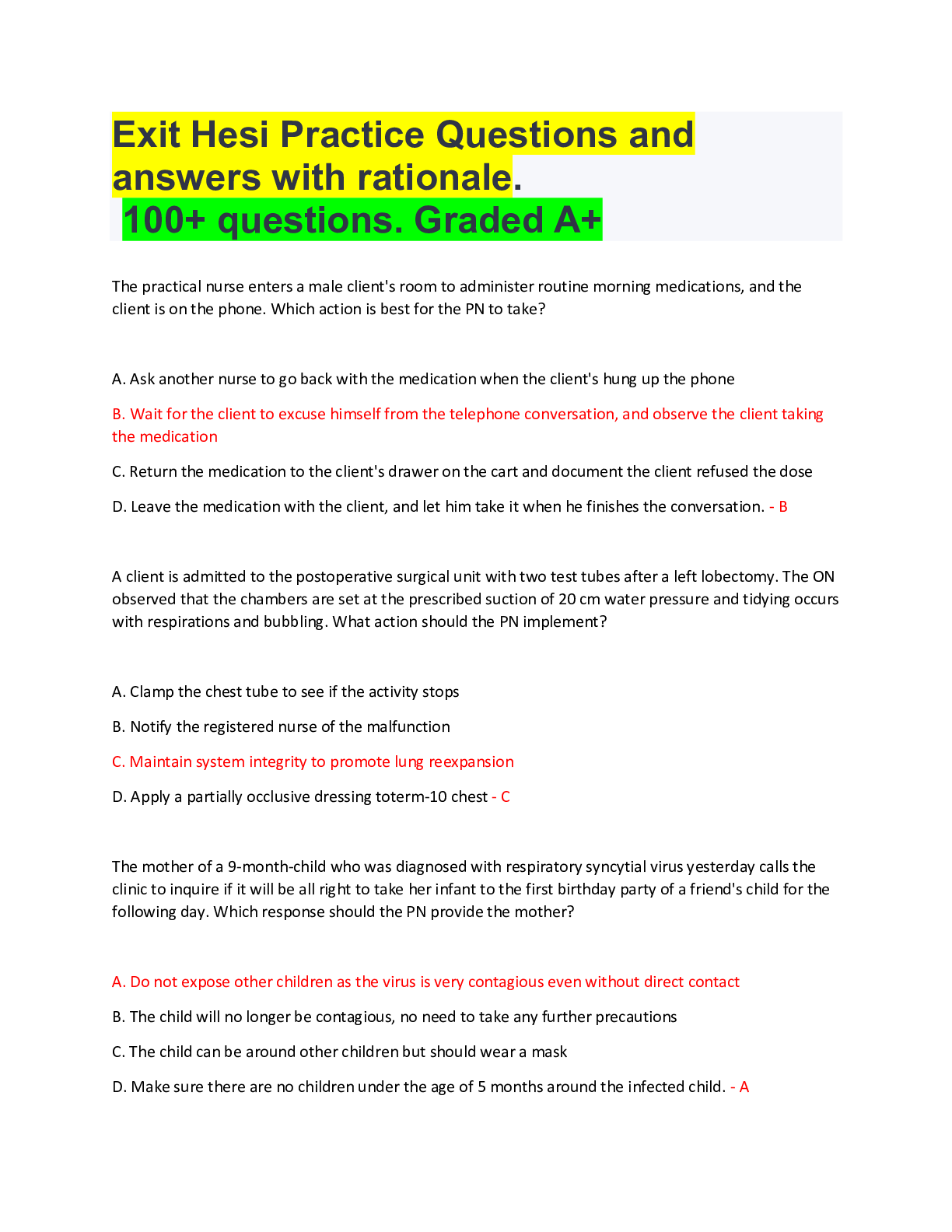

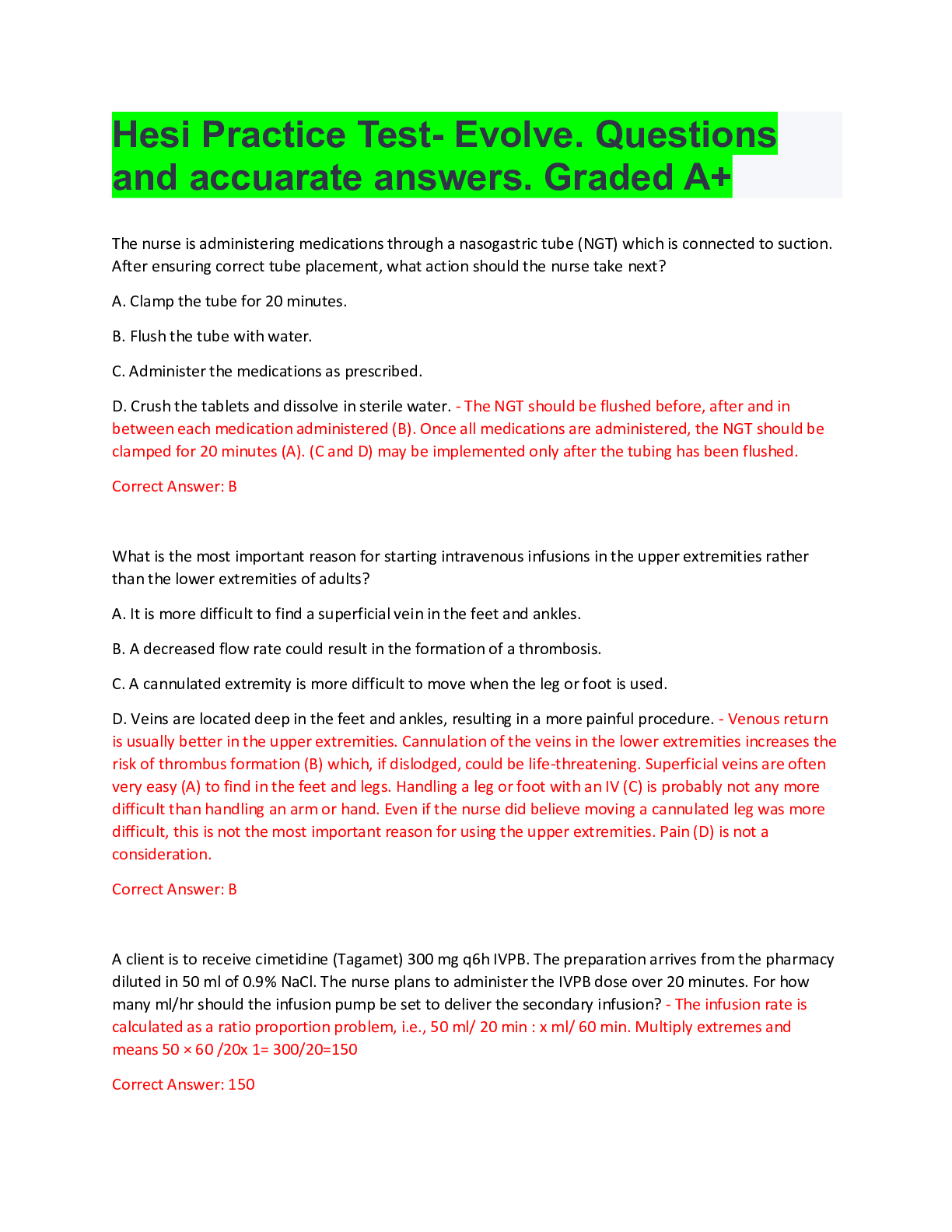
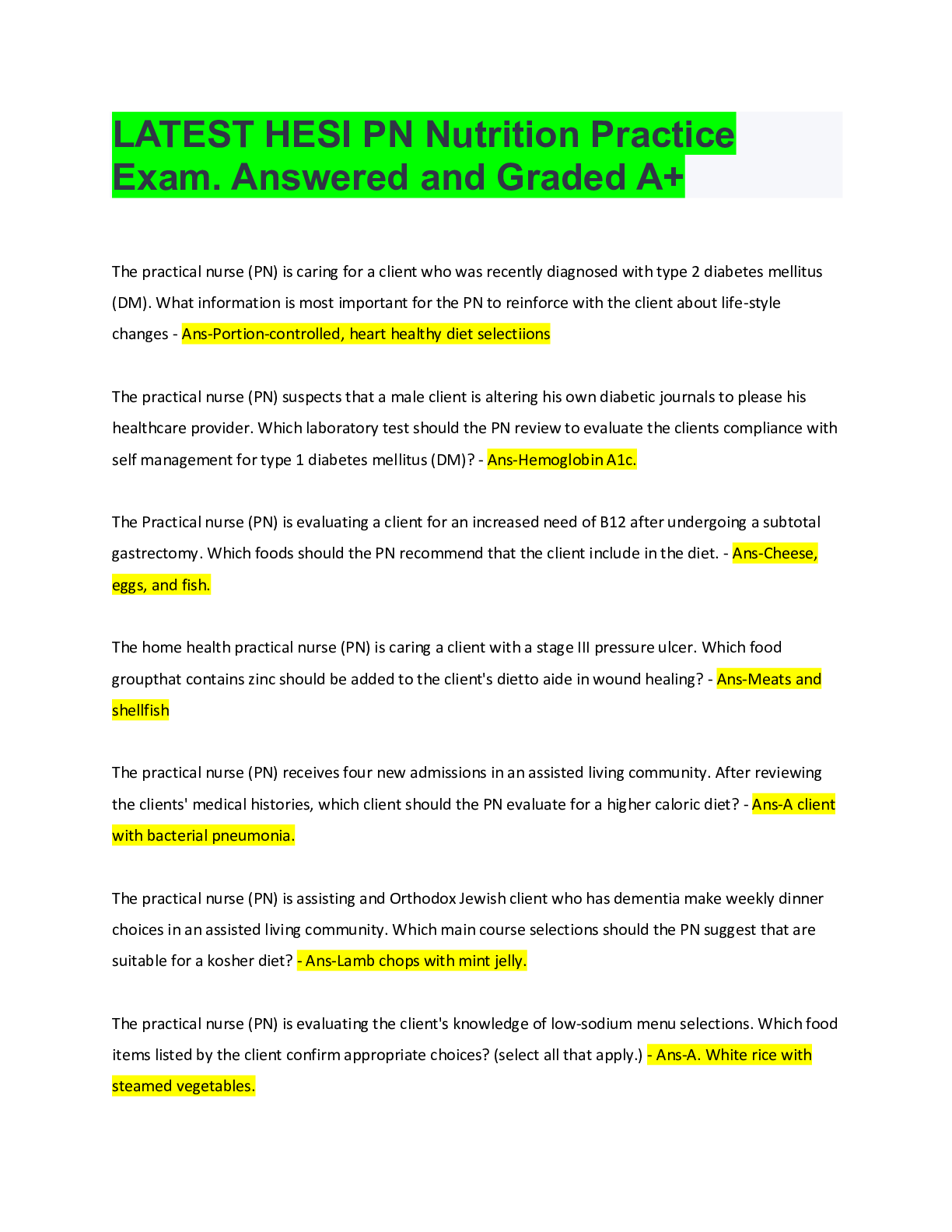


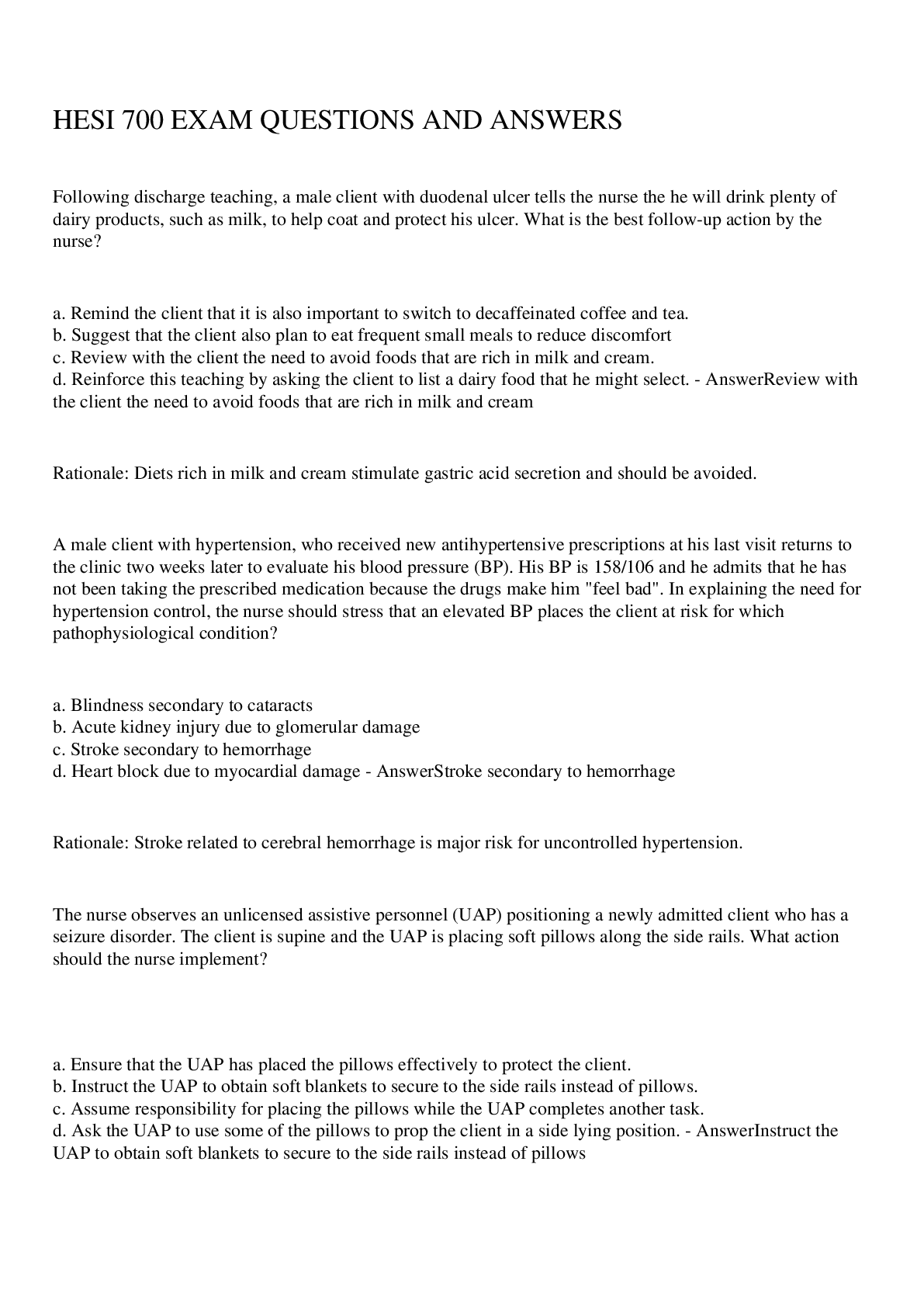


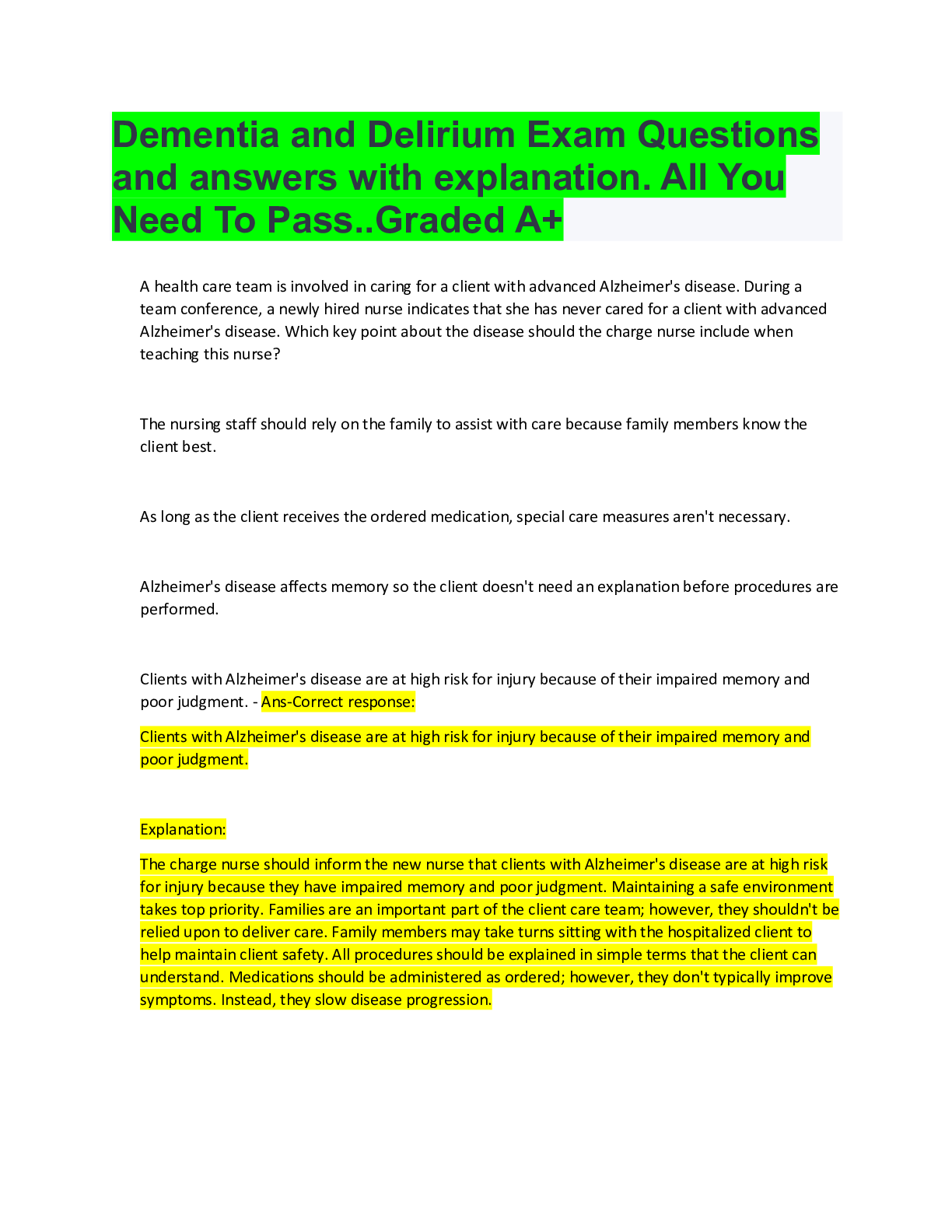


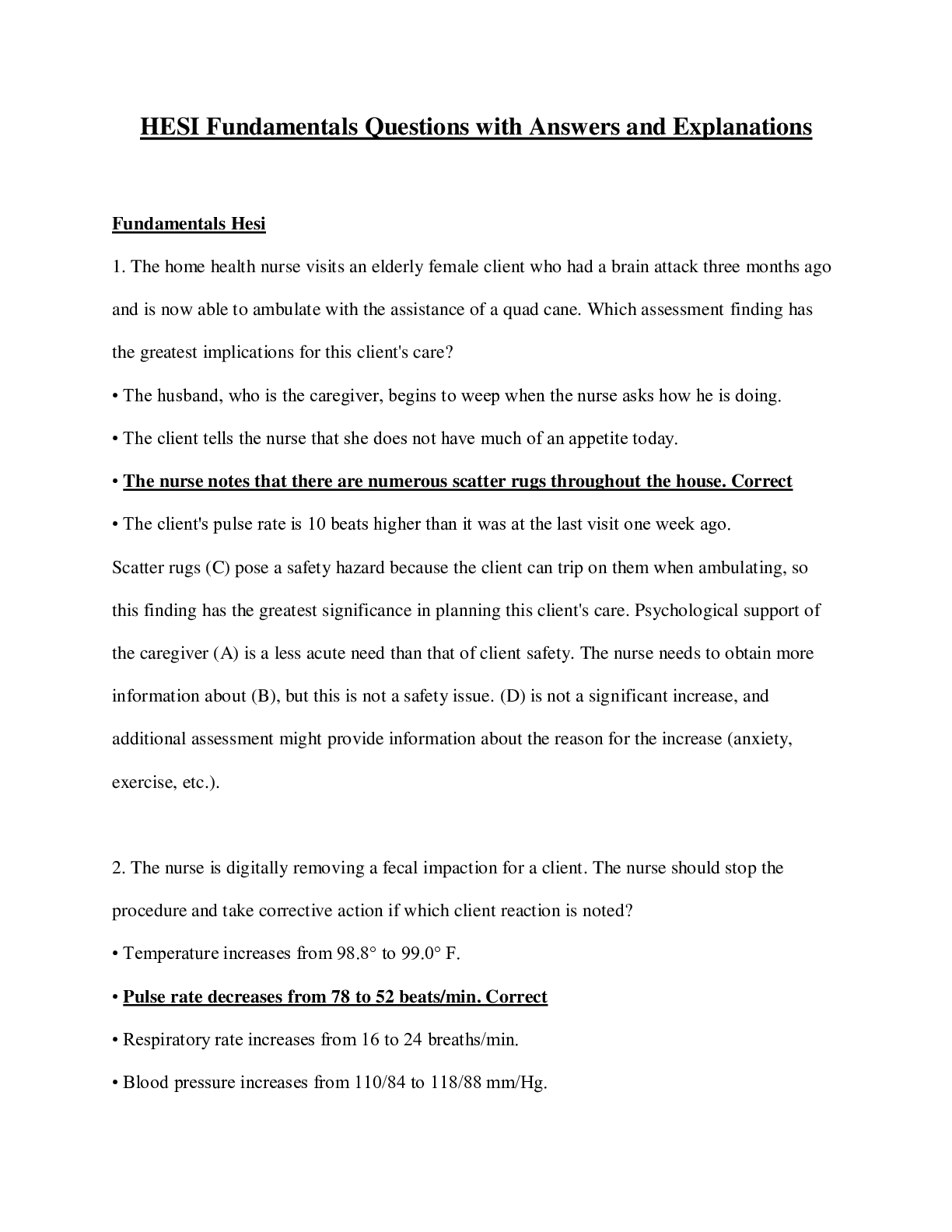
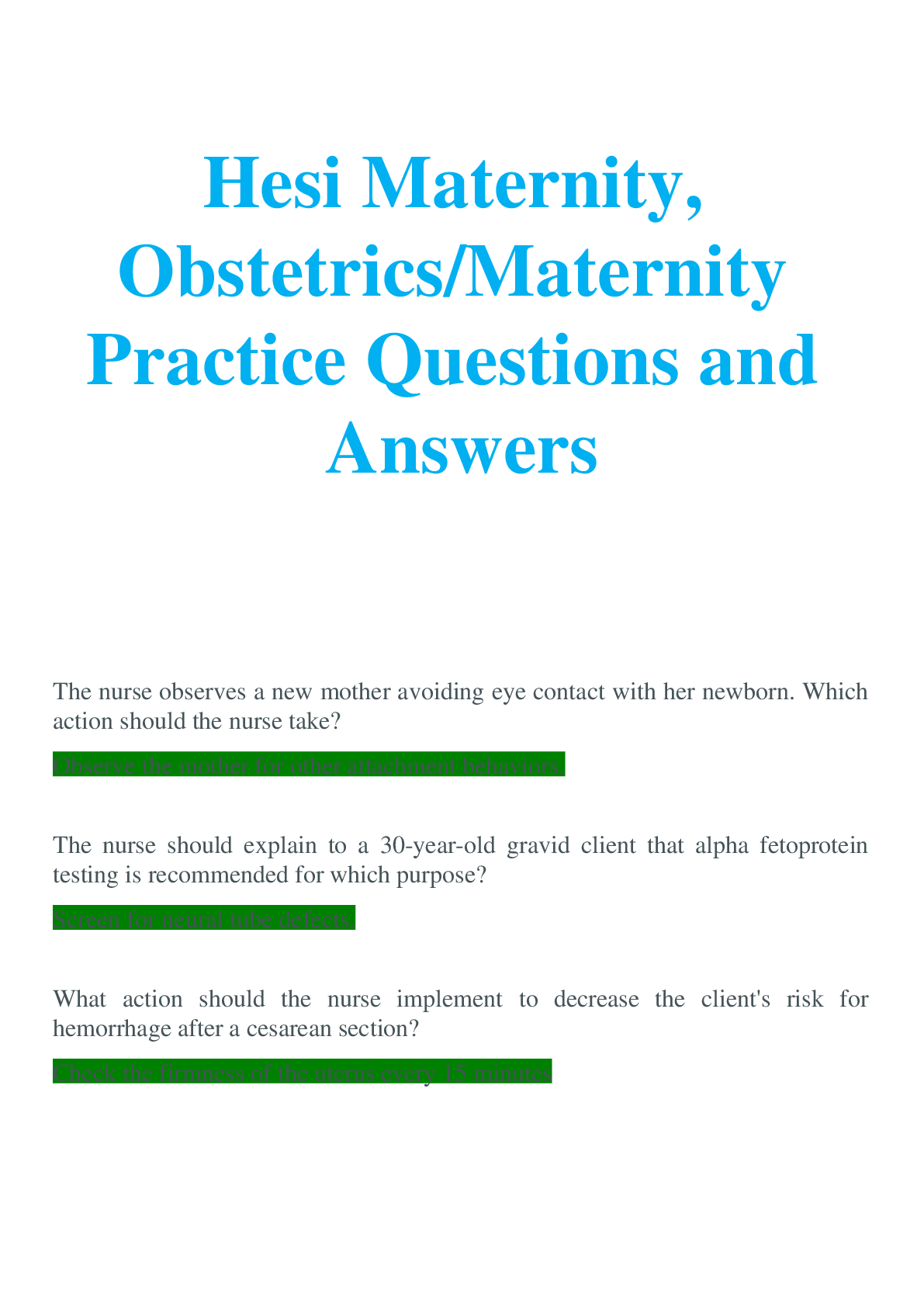
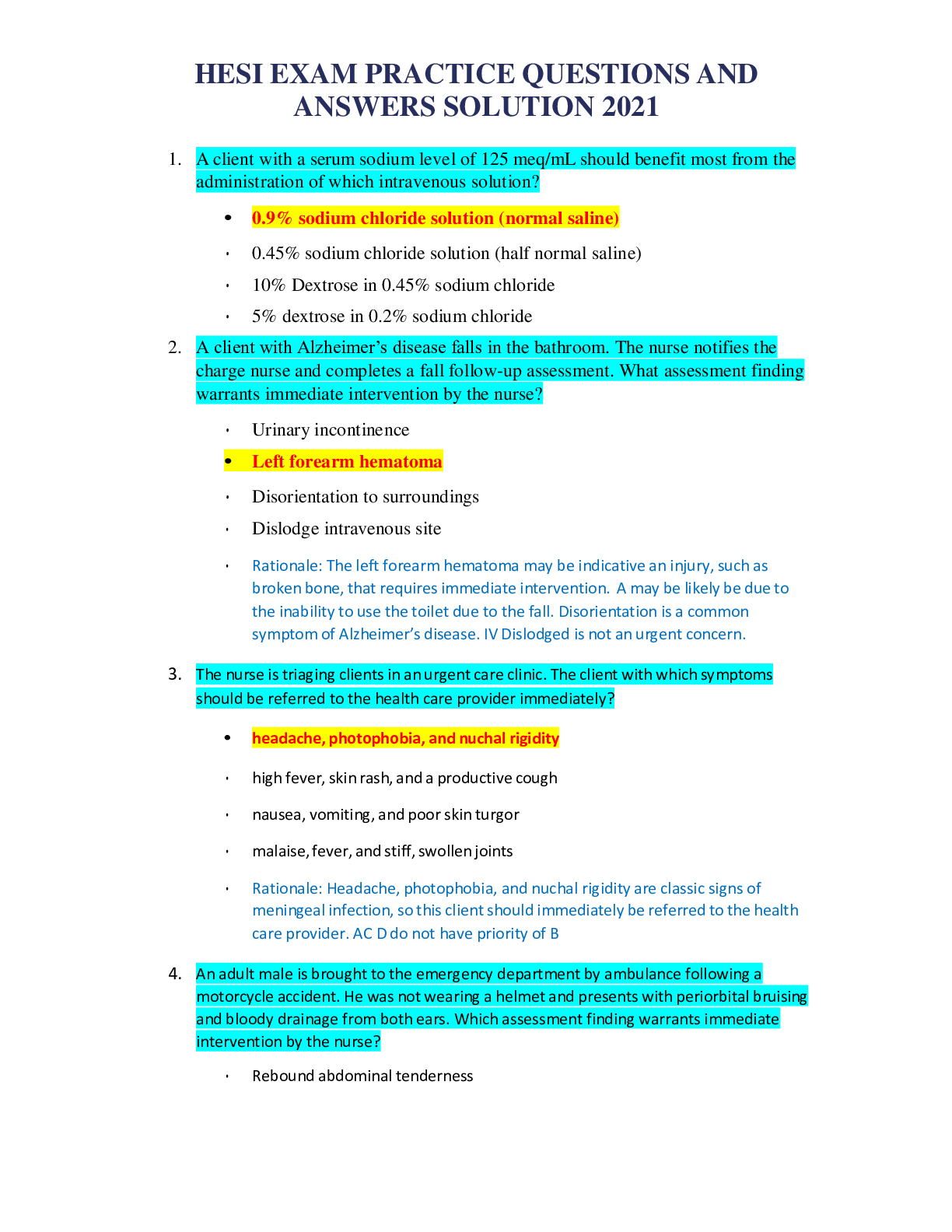




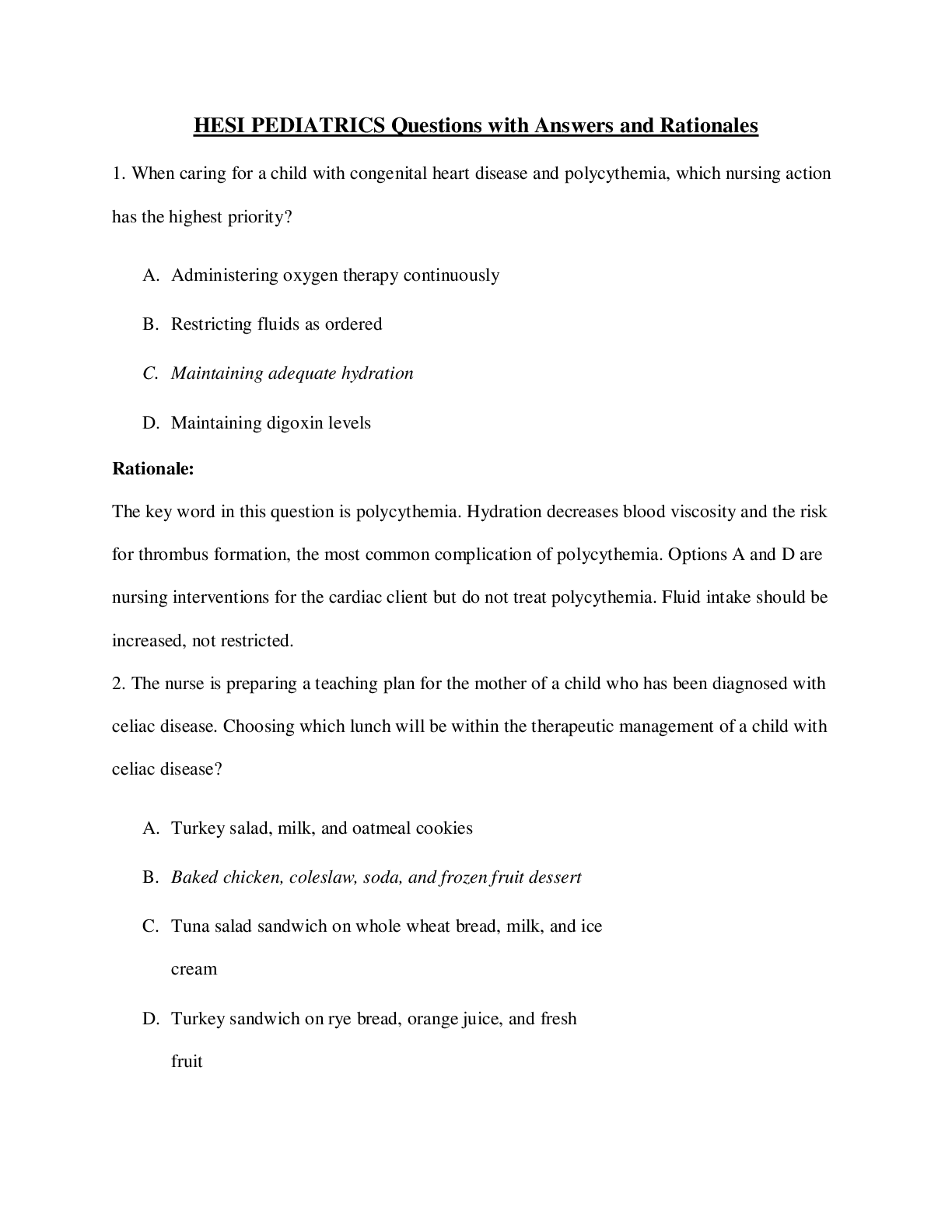
.png)
